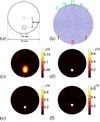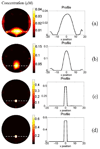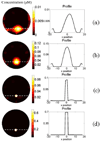Quantitative fluorescence tomography with functional and structural a priori information
- PMID: 19252634
- PMCID: PMC2737514
- DOI: 10.1364/ao.48.001328
Quantitative fluorescence tomography with functional and structural a priori information
Abstract
We demonstrate the necessity of functional and structural a priori information for quantitative fluorescence tomography (FT) with phantom studies. Here the functional a priori information is defined as the optical properties of the heterogeneous background that can be measured by a diffuse optical tomography (DOT) system. A CCD-based noncontact hybrid FT/DOT system that could take measurements at multiple views was built. Multimodality phantoms with multiple compartments were constructed and used in the experiments to mimic a heterogeneous optical background. A 3.6 mm diameter object deeply embedded in a heterogeneous optical background could be localized without any a priori information, but the recovered fluorophore concentration only reached one tenth of the true concentration. On the other hand, the true fluorophore concentration could be recovered when both functional and structural a priori information is utilized to guide and constrain the FT reconstruction algorithm.
Figures





Similar articles
-
Fluorescence diffuse optical tomography with functional and anatomical a priori information: feasibility study.Phys Med Biol. 2007 Sep 21;52(18):5569-85. doi: 10.1088/0031-9155/52/18/007. Epub 2007 Sep 3. Phys Med Biol. 2007. PMID: 17804882
-
Feasibility study of high spatial resolution multimodality fluorescence tomography in ex vivo biological tissue.Appl Opt. 2017 Oct 1;56(28):7886-7891. doi: 10.1364/AO.56.007886. Appl Opt. 2017. PMID: 29047774 Free PMC article.
-
A gantry-based tri-modality system for bioluminescence tomography.Rev Sci Instrum. 2012 Apr;83(4):043708. doi: 10.1063/1.3698295. Rev Sci Instrum. 2012. PMID: 22559540 Free PMC article.
-
Quantitative fluorescence tomography using a combined tri-modality FT/DOT/XCT system.Opt Express. 2010 Apr 12;18(8):7835-50. doi: 10.1364/OE.18.007835. Opt Express. 2010. PMID: 20588625 Free PMC article.
-
Diffuse optical tomography guided quantitative fluorescence molecular tomography.Appl Opt. 2008 Apr 20;47(12):2011-6. doi: 10.1364/ao.47.002011. Appl Opt. 2008. PMID: 18425173
Cited by
-
Visualization of upconverting nanoparticles in strongly scattering media.Biomed Opt Express. 2014 May 28;5(6):1952-64. doi: 10.1364/BOE.5.001952. eCollection 2014 Jun 1. Biomed Opt Express. 2014. PMID: 24940552 Free PMC article.
-
Shape-parameterized diffuse optical tomography holds promise for sensitivity enhancement of fluorescence molecular tomography.Biomed Opt Express. 2014 Sep 16;5(10):3640-59. doi: 10.1364/BOE.5.003640. eCollection 2014 Oct 1. Biomed Opt Express. 2014. PMID: 25360379 Free PMC article.
-
Split operator method for fluorescence diffuse optical tomography using anisotropic diffusion regularisation with prior anatomical information.Biomed Opt Express. 2011 Sep 1;2(9):2632-48. doi: 10.1364/BOE.2.002632. Epub 2011 Aug 19. Biomed Opt Express. 2011. PMID: 22091447 Free PMC article.
-
Radiologic and near-infrared/optical spectroscopic imaging: where is the synergy?AJR Am J Roentgenol. 2010 Aug;195(2):321-32. doi: 10.2214/AJR.10.5002. AJR Am J Roentgenol. 2010. PMID: 20651186 Free PMC article. Review.
-
Three-dimensional reconstruction in free-space whole-body fluorescence tomography of mice using optically reconstructed surface and atlas anatomy.J Biomed Opt. 2009 Nov-Dec;14(6):064010. doi: 10.1117/1.3258836. J Biomed Opt. 2009. PMID: 20059248 Free PMC article.
References
-
- Ntziachristos V, Ripoll J, Wang LV, Weissleder R. Looking and listening to light: the evolution of whole-body photonic imaging. Nat. Biotechnol. 2005;23:313–320. - PubMed
-
- Bremer C, Ntziachristos V, Weitkamp B, Theilmeier G, Heindel W, Weissleder R. Optical imaging of spontaneous breast tumors using protease sensing ‘smart’ optical probes. Invest. Radiol. 2005;40:321–327. - PubMed
-
- Becker A, Hessenius C, Licha K, Ebert B, Sukowski U, Semmler W, Wiedenmann B, Grotzinger C. Receptortargeted optical imaging of tumors with near-infrared fluorescent ligands. Nat. Biotechnol. 2001;19:327–331. - PubMed
-
- Pu Y, Wang WB, Tang GC, Zeng F, Achilefu S, Vitenson JH, Sawczuk I, Peters S, Lombardo JM, Alfano RR. Spectral polarization imaging of human prostate cancer tissue using a near-infrared receptor-targeted contrast agent. Technol. Cancer. Res. Treat. 2005;4:429–436. - PubMed
-
- Ntziachristos V. Fluorescence molecular imaging. Annu. Rev. Biomed. Eng. 2006;8:1–33. - PubMed
Publication types
MeSH terms
Substances
Grants and funding
LinkOut - more resources
Full Text Sources
Other Literature Sources

